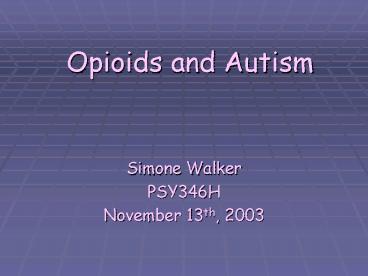Opioids and Autism - PowerPoint PPT Presentation
1 / 18
Title:
Opioids and Autism
Description:
Gluten and gliadin. Found in wheat and other cereals. give rise to gluteomorphines and ... Effects of a gluten and casein-free diet on the symptoms of autism. ... – PowerPoint PPT presentation
Number of Views:53
Avg rating:3.0/5.0
Title: Opioids and Autism
1
Opioids and Autism
- Simone Walker
- PSY346H
- November 13th, 2003
2
Overview
- Introduction Opioid system
- Opioid theory of autism
- ? Exogenous opioids
- ? Endogenous opioids
- Naltrexone
- Conclusion
3
The Opioid System
- Group of naturally occurring peptides
- ? met-enkephalin, leu-enkephalin and
- beta-endorphin.
- Act as both neurotransmitters and hormones
- Regulation of pleasure and pain as well as
reward. - Regulation of human emotional responses
Zubieta, et al., 2003
4
The Opioid Theory of Autism
- An early, long-term overload of the CNS by
opioids. - Opioid dysfunction may underlie social and
emotional impairments, attention deficits,
hyperactivity, self-injurious behaviour.
Reichelt, Sælid, Lindback, Bøler, 1986
Sahley Panksepp, 1987
5
Exogenous Opioids
- Derived from diet
- Gluten and gliadin
- ? Found in wheat and other cereals.
- ? give rise to gluteomorphines and
- gliadinmorphines respectively.
- Casein
- ? Found in milk and milk products.
- ? Gives rise to caseomorphines.
Whiteley Shattock, 2002
6
Exogenous Opioids Cont
- Autism is a metabolic disorder.
- Opioid peptides from dietary sources pass through
an abnormally permeable intestinal membrane. - Abnormalities in blood-brain barrier
- Enter CNS where they affect neurotransmission.
Whiteley Shattock, 2002
Berney, 2000
Whiteley Shattock, 2002
7
Exogenous Opioids Cont
- Whiteley Shattock review (2002) found that
studies consistently found urinary peptide
abnormalities in autistic vs normal controls. - High levels of opioids also found in plasma and
spinal fluid in autistic individuals.
Reichelt, Sælid, Lindback, Bøler, 1986
8
Exogenous Opioids Cont
- Effects of a gluten and casein-free diet on the
symptoms of autism. - Single-blind, randomized design.
- 10 kids (7 years old) with autism and abnormal
urinary peptide patterns - 10 age-matched control kids
- Tested on a number of clinical and behavioural
scales before and after treatment.
Knivsberg, Reichelt, Hølen, Nødland, 2002
9
Exogenous Opioids Cont
- Special diet produced a significant improvement
in aloofness, distraction, adjustment to novel
situations, ritualistic behaviour, resistance to
learning, inappropriate emotions and motor
skills. - Improvements were small but remarkable.
- Small sample size
- Single-blind design
10
Endogenous Opioids
- Mostly ß-endorphin.
- Autism may be a failure of striatal ß-endorphin
to diminish with maturation - Conflicting evidence of elevated levels of
ß-endorphin. - ? Sandman, et al., 1997
- ? Nagamitsu, et al., 1997
Panksepp, 1979
11
Endogenous Opioids Cont
- More recently autism and POMC
- ? Proopiomelanocortin
- ? Mammalian endocrine precursor for
- endorphins, ACTH, melatonin.
- ? mostly produced in anterior pituitary.
- In a subgroup of autistic children POMC
- dysfunction results in abnormal levels of ACTH
- and opioids in bloodstream.
Chamberlain Herman, 1990
Sandman, et al., 1997
12
Endogenous Opioids
- Elevated plasma levels of ß-endorphin fragment in
autistic children and their mothers. - POMC and resulting fragments involved in HPA axis
acute stress response - Overreaction to acute stressors due to opioid
excess in CNS.
Leboyer, et al., 1994
Tordjman, et al., 1997
13
Naltrexone
- Naltrexone
- ? Pure opioid antagonist
- ? Modest improvements in hyperactivity
- and self-injurious behaviour.
- ? Sensory/pain threshold
- ? Pleasure associated with opioid
- release
Sandman, et al., 1997 Bouvard, et al., 1995
Sandman, et al., 2002
14
Naltrexone
- Reduced peripheral blood levels of ß-endorphin in
7 of 11 autistic children after 12 weeks of
treatment - Correlated reduction in social withdrawal and
other symptoms.
Cazullo, et al., 1999
15
Naltrexone Cont
- Long-term benefits of naltrexone
- 6 autistic children who had previously shown
reductions in hyperactivity after 4 weeks of
naltrexone. - After 6 months, scores on the Aberrant Behaviour
Checklist were lower than baseline for 5 out of 6
kids.
Willemsen-Swinkels, et al., 1999
16
Naltrexone Cont
- What does Naltrexone treatment tell us?
- ? Modest improvements
- ? Symptom attenuation
Berney, 2000
17
Conclusion
- Evidence supports theory that opioid
excess/overactivity involved in autism - Do not know whether it is main contributor or
part of interaction with other systems E.g.
serotonin - Treatments such as a restricted diet and
naltrexone are promising but more studies with
larger samples are needed.
18
Thank You































